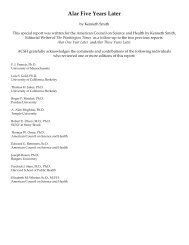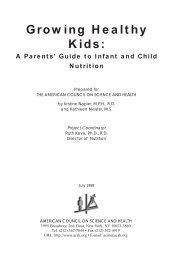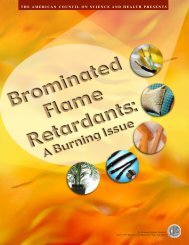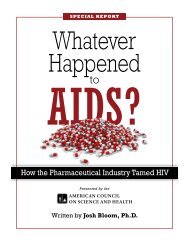The Role of Beef in the American Diet - International Meat Secretariat
The Role of Beef in the American Diet - International Meat Secretariat
The Role of Beef in the American Diet - International Meat Secretariat
Create successful ePaper yourself
Turn your PDF publications into a flip-book with our unique Google optimized e-Paper software.
<strong>The</strong> <strong>Role</strong> <strong>of</strong> <strong>Beef</strong> <strong>in</strong> <strong>the</strong> <strong>American</strong> <strong>Diet</strong><br />
• Substances called heterocyclic am<strong>in</strong>es may form <strong>in</strong> meat dur<strong>in</strong>g<br />
some cook<strong>in</strong>g procedures that use high temperatures. <strong>The</strong>se substances,<br />
like <strong>the</strong> many o<strong>the</strong>r naturally occurr<strong>in</strong>g animal carc<strong>in</strong>ogens<br />
<strong>in</strong> food, are not a major cause for concern when consumed <strong>in</strong> small<br />
amounts. However, consumers who wish to reduce <strong>the</strong>ir exposure to<br />
heterocyclic am<strong>in</strong>es can do so by adjust<strong>in</strong>g <strong>the</strong>ir cook<strong>in</strong>g methods.<br />
• <strong>The</strong> use <strong>of</strong> hormones to promote growth <strong>in</strong> beef cattle helps to keep<br />
<strong>the</strong> cost <strong>of</strong> beef down. <strong>The</strong>se hormones, when used correctly, pose no<br />
health risks for human consumers.<br />
• <strong>The</strong> correct use <strong>of</strong> antibiotics <strong>in</strong> <strong>the</strong> production <strong>of</strong> beef cattle and<br />
o<strong>the</strong>r animals does not create residue problems. However, this practice,<br />
like o<strong>the</strong>r uses <strong>of</strong> antibiotics, may contribute to <strong>the</strong> development<br />
<strong>of</strong> antibiotic resistant bacteria. <strong>The</strong> extent to which <strong>the</strong> use <strong>of</strong> antibiotics<br />
<strong>in</strong> animal agriculture contributes to <strong>the</strong> overall problem <strong>of</strong><br />
antibiotic resistance is uncerta<strong>in</strong>. Never<strong>the</strong>less, experts agree that<br />
antibiotics should be used judiciously and only when necessary, and<br />
<strong>the</strong> Food and Drug Adm<strong>in</strong>istration has begun to take <strong>the</strong> issue <strong>of</strong><br />
antibiotic resistance <strong>in</strong>to account when mak<strong>in</strong>g decisions about <strong>the</strong><br />
approval <strong>of</strong> new animal drugs.<br />
• Efforts are currently be<strong>in</strong>g made <strong>in</strong> <strong>the</strong> production system to reduce<br />
<strong>the</strong> likelihood that beef will be contam<strong>in</strong>ated with E. coli O157:H7<br />
or Salmonella. Never<strong>the</strong>less, adequate cook<strong>in</strong>g and proper food handl<strong>in</strong>g<br />
techniques by consumers and food service personnel are <strong>the</strong><br />
f<strong>in</strong>al and most important defense aga<strong>in</strong>st <strong>the</strong>se foodborne bacteria.<br />
Ano<strong>the</strong>r bacterium, Listeria monocytogenes, is sometimes found <strong>in</strong><br />
processed, refrigerated food products, <strong>in</strong>clud<strong>in</strong>g beef products (such<br />
as deli meats). This organism poses special hazards for pregnant<br />
women. It has been recommended that high risk <strong>in</strong>dividuals should<br />
thoroughly reheat processed meats, such as hot dogs and cold cuts,<br />
before eat<strong>in</strong>g <strong>the</strong>m.<br />
• Raw foods <strong>of</strong> animal orig<strong>in</strong>, <strong>in</strong>clud<strong>in</strong>g beef and o<strong>the</strong>r meats, need to<br />
be handled carefully and cooked adequately for safety. Although<br />
<strong>in</strong>tact pieces <strong>of</strong> beef (steaks and roasts) can be served medium rare<br />
(cooked to 145°F), ground beef should always be cooked thoroughly,<br />
to at least 160°F. Consumers should use a food <strong>the</strong>rmometer to determ<strong>in</strong>e<br />
when foods are sufficiently cooked, ra<strong>the</strong>r than rely<strong>in</strong>g on color<br />
6










